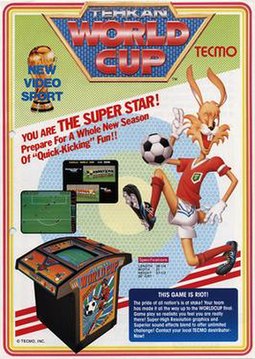Tehkan World Cup
| Tehkan World Cup | |
|---|---|

North American arcade flyer
|
|
| Developer(s) | Tehkan |
| Publisher(s) | Tecmo |
| Composer(s) | Tsukasa Masuko |
| Platform(s) | Arcade |
| Release | |
| Genre(s) | Sports game (soccer) |
| Mode(s) |
Single-player Multiplayer |
| Display | Color raster, horizontally orientated |
Tehkan World Cup, aka. Tecmo Cup, is the first multi-player soccer game featuring a trackball controller. Programmed by Michishito Ishizuka it was released to arcades in 1985 by Tehkan, Ltd., the former name of Tecmo, Inc. Its arrival coincided with the buildup to the 1986 FIFA World Cup. It featured the then colors of several of the world's top teams such as West Germany, Argentina and Brazil, although it did not mention any team by name. It was most commonly released in a cocktail cabinet form factor, while graphically it offered a two-dimensional birds-eye view of the field that was unique for its time. Its trackball control system contributed significantly to its gameplay which was relatively speedy and exhibited a fluidity something akin to ice hockey, with as little as 3 seconds required to score from kick-off. Two-player action could be highly competitive, with players facing each other across the game space while using sweeping arm movements reminiscent of table tennis. Mechanical reliability proved to be the game's Achilles' heel, as the physical nature of play necessitated regular maintenance on high-wear components.
Tehkan World Cup was released in 2004 for the PlayStation 2 and in 2005 for the Xbox, in both cases under the name Tecmo Cup.
Unlike later games such as the FIFA series, Tehkan World Cup automates several elements of control related to releasing and receiving the ball. When passing and shooting, the velocity, direction and to some extent the height of the ball are determined by the human players, but not the method by which the virtual player must execute these instructions. The part of the body used (for example, left foot, right foot, head, chest or knee) while dependent largely on the height of the ball, is determined automatically by the game. In some cases, whether the virtual player must first control the ball before releasing it again, or whether they may pass or shoot with their first touch, is also determined by the computer. These simplifications, perhaps made under the assumption that World Cup-caliber players have fully mastered the basics of the sport, allow human players to concentrate on the context of play, resulting in gameplay that is more flowing and free of technical error. The movements of players off the ball and team formations are also fully automated.
...
Wikipedia
